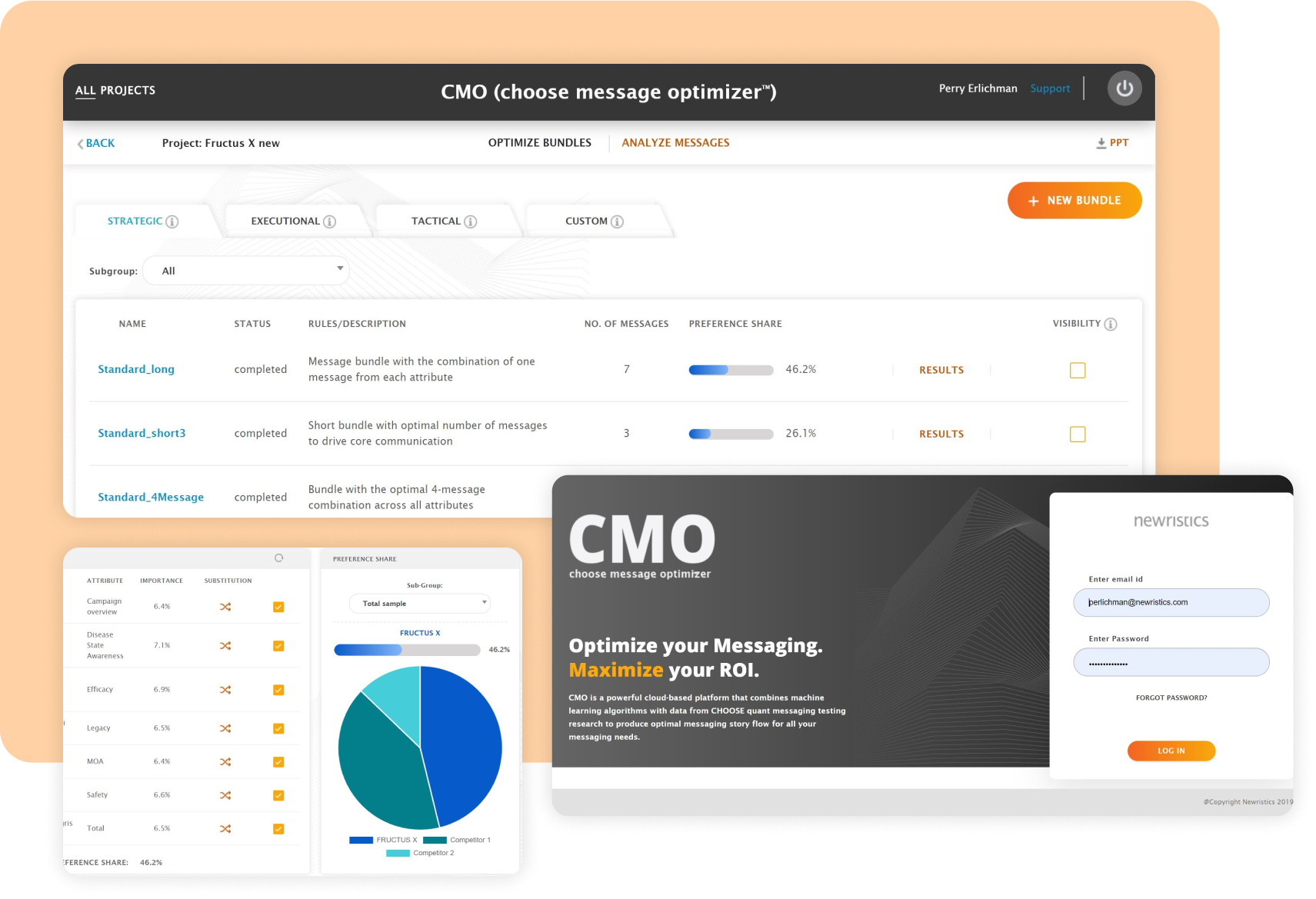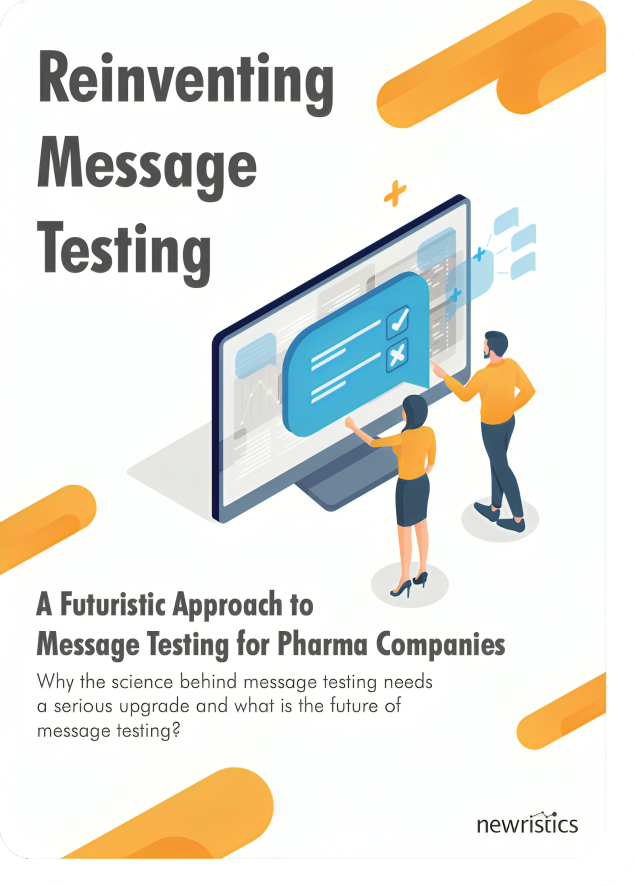-
ServiceContent Creation
Optimize Pharma GTM communications
-
Market Research
Innovative messaging market research
-
Machine Learning
Analyze messaging with algorithms
Optimize Pharma GTM communications
Innovative messaging market research
Analyze messaging with algorithms
Source for pharma insights and updates
Pharma's top behavioral science source
Superior quant message testing methodology for pharma brands
LEARN MORE





















Data from CMO studies is loaded into an easy-to-use AI platform where you can optimize message bundles and storyflows for all your campaign needs.
Why testing a lot of messages is important for your brand
Based on a meta-analysis of 75+ studies testing 16,000+ messages with 34,000+ respondents
Read Special Report
Delivered winning messaging storyflows that outperformed all benchmarks

Produced message bundles with 1.7 times higher preference share

Helped 7 out of 10 brands take or extend market leadership

Get your message refresh to market in half the time
All you need to provide is a draft inventory of messages
Fewer research studies, 50% lower research budget for message testing
1.7 times higher preference share for winning message bundles
We have a list of frequently asked questions for you
Customer market research is regularly used to test “ideas” before launching them in the market. Ideas can be tested in the form of new product concepts, positioning statements, messages, etc.
Message testing market research is typically used to identify messages with the greatest customer appeal, prioritize messages from best to worst, get insights about why a message has high/medium/low appeal, and get ideas on how to improve messages. A message testing survey allows you to test messages with your existing customers before they are launched in marketing campaigns so that you can anticipate how well the campaign will likely perform. Campaign message testing also helps brand teams optimize their campaigns and make improvements on a continuous basis while the campaign is live.
Market researchers and marketers can pick from a variety of message testing methodology options to test messages before launch. Qualitative message testing market research includes personal conversations with customers in the form of focus groups, diads/triads, or even one-on-one interviews. These conversations can take place in-person, on the phone or in web chat rooms and are typically facilitated by an interviewer or moderator.
Quantitative message testing market research involves the use of online surveys in which customers are asked to review messages and rank/rate them based on preference. More advanced message testing surveys include choice-based methodologies which expose respondents to a series of messaging choices and ask them to make preferences.
With the increasing use of digital channels for messaging activation, A/B message testing softwares have also emerged as a popular option for message testing. Instead of testing messages in market research before launching campaigns, marketers are testing messages in-market through A/B message testing software platforms and optimizing campaigns on the fly based on open/click through rates.
All message testing methodologies have their own pros/cons. Qualitative message testing market research is excellent at diving deep into individual messages to understand the psychology behind each one. However, qualitative message testing interviews can’t handle too many messages and the responses are stated and subject to many biases.
Quantitative message testing surveys can test a lot more messages, but they do not allow for deep exploration of each message and don’t provide detailed drivers/barriers of appeal for each message. Quantitative message testing software is also not well suited to get ideas from respondents on how to improve messages.
An ideal message testing software would overcome the shortcomings of conventional qualitative and quantitative message testing market research methodologies and produce a deliverable that includes the following:
Decision heuristics science is the three-time Nobel prize-winning field of research that explains how human beings make decisions using mental shortcuts. Over the last 30 years, hundreds of specific decision heuristics have been discovered about human decision-making. In the context of customer behavior, heuristics can help us understand why customers respond to certain messages or product offerings.
Decision heuristics science can be used in multiple ways for message testing. First, it can be used as a message optimizing software which can improve language in messages before they're tested with customers. Second, it can also be used during the research as a powerful message testing market research methodology. When messages are tested in a message testing survey using heuristics, all respondents have to do is make choices and the drivers of their preferences are explained by the underlying heuristics behind each message
Artificial intelligence can be used to make the output of message testing surveys more actionable and campaign ready. Historically, data from message testing market research studies would be loaded into statistical software systems like SPSS and the output would be standard message hierarchies and/or a TURF analysis. Using artificial intelligence on data collected from message testing software can produce optimal message bundles and story flow out of billions of possibilities and even personalize them down to the segment and channel level. With AI-powered campaign message testing, you can get a channel- and customer-specific messaging playbook that is ready to execute.
While there has been significant innovation in how messages are developed and executed in the marketplace over the past 30 years, little to no innovation has been brought forward on how messages are tested with customers before they're launched in campaigns.
What marketers need in today's hyper-competitive environment to be launch ready for their next marketing campaign with a messaging playbook that has the optimal message bundles and storyflows for every segment and channel of communication. Conventional message testing market research methodologies were simply not designed to produce the deliverables that today's marketers need. New innovation is needed in message testing research see help marketers be more launch ready and to reduce course correction in marketing campaigns.